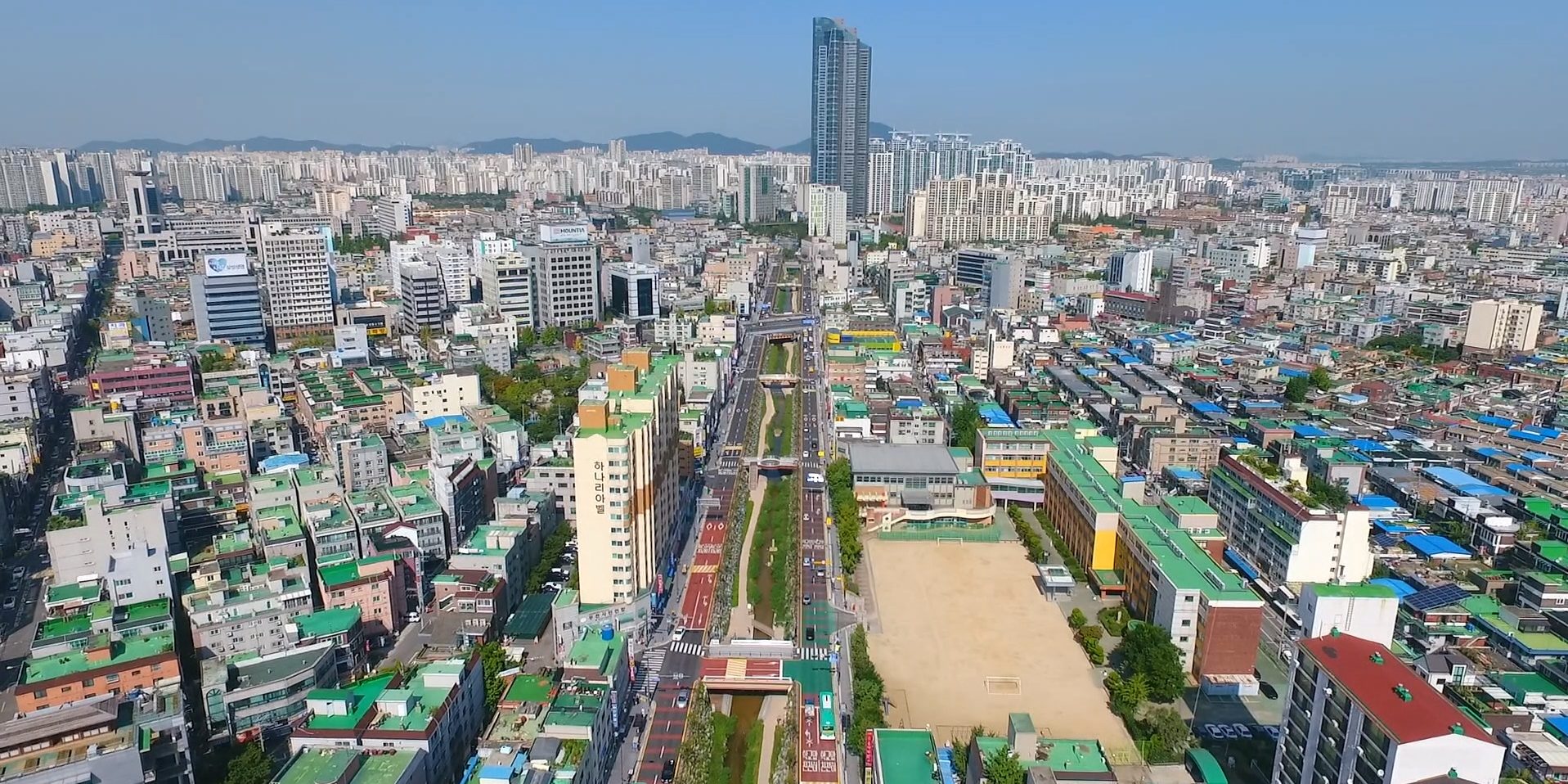By Beatrice Ch’ng, Ecomobility Officer, ICLEI – Local Governments for Sustainability
The City of Bucheon, located between Seoul and Incheon in the western part of South Korea, is a charming and bustling city. It prides itself on being a center of culture, information, and industry. Approximately 55 sq km, Bucheon is home to almost 900,000 people, making it the second most populated satellite city after Metropolitan Seoul. Like its neighboring cities, Bucheon experienced massive growth during Korea’s rapid urbanization in the 1970s. New city areas and facilities were established in the 1990s and 2000s, such as the four major higher education institutions, a philharmonic orchestra and colorful parks that host annual festivals.
The Opportunity
In the 1970s, Bucheon followed the car-centric trajectory of many of the world’s cities, resulting in major traffic congestion. The city expanded existing roads and built new arterial roads and overpasses. Even the Simgokcheon Stream that meanders through the old town from the east to the west was covered with concrete to make space for cars. Narrow sidewalks made walking almost impossible, especially for children, the elderly and people with reduced mobility. As a result, the city faced gridlock, air pollution, and a lack of public spaces.
Over the past decade, Bucheon has fundamentally changed its transport model. In 2010, the city government implemented a groundbreaking “pedestrian-centric transportation policy.” The policy prioritizes pedestrians, cyclists, and transit users. Bucheon set four goals for this new vision: (1) improve walkability; (2) create green networks and urban forest; (3) expand cycling paths; and (4) increase the use of public transportation.
Walkability
Making the city walkable is not only about expanding walking networks but creating destinations. Bucheon designed walking paths connecting the city’s 188 libraries. As libraries are a cultural touchstone, the purpose of connecting libraries and paths was to provide access to knowledge. The city also opened book cafes along streets, delivered books to the elderly and disabled, and set up small libraries in busy subway stations. This resulted in more people using libraries and public transportation. The number of pedestrians increased, and green space around the libraries grew by almost 40%. Today, the city plans to increase the number of libraries and expand the walking network.
Urban Forests
Urban forests improve the quality of life for residents. Not only are trees beautiful, but they can lower cortisol levels in people, which means less stress. Bucheon created an urban forest by designing a network of trees and connected waterways. The city adopted a participatory approach by inviting residents to give input on paving materials, maintenance systems, and other details. Community gardens were also cultivated through a series of donations and volunteer activities.
In 2017, Bucheon began the restoration of the Simgokcheon Stream which had been a highway cum sewage system since 1986. The revitalization involved the creation of 40 km of waterways, connecting the main streams and rivers, and planting various plants to restore the ecosystem. Overall, the green area per person increased from 4.48 sq meters to 5.45 sq meters. The new green spaces also reduced the heat island effect, a phenomenon in which urban areas are warmer than surrounding rural areas because of their paved surfaces and human activity.
Cycling for All
The city has encouraged cycling by building 200 km of paths and installing bike parking stations at every subway for seamless connectivity. It also runs seven public bike sharing and repair services, that served 15,892 people in 2017. Unlike other cities that rely on technology to manage bike sharing systems, Bucheon staffs its stations with people to promote social interaction. To celebrate the cycling community, the city hosts an annual Grand Bike Festival with over 5,000 participants.
The number of bicyclists increased by 11% between 2010 and 2017. After a bicycle insurance policy began in February 2018, cycling increased from 12.9% to 26%. All residents registered with the city are automatically insured. This insurance covers injuries, hospitalization, permanent disability, and fatalities. To keep people safe, the city plans to teach 30,000 residents how to ride in urban areas. The city also plans to extend the cycling network to 250 km.
Improving Public Transport
To increase public transport ridership and reduce traffic congestion, metro lines and stations are being upgraded with new stations and trains. Recent service improvements on the metro lines increased ridership by 67% in one year. The new Sosa-Wonsi metro line that opened this year will serve even more residents.
Three metro stations were converted into community squares: the Maru Square, Rainbow Square, and Dahaeng Square. The connecting metro stations were also improved by integrating them with buses and taxis. Exciting cultural performances take place at these squares daily––Bucheon is the “Special City of Culture.” These changes generated an economic benefit of over 500 million dollars.
More than Mobility
As a result of Bucheon’s progressive people-friendly and ecomobile transport policy*, passenger cars decreased by 3.2%, while the number of pedestrians and cyclists increased by 5% and 15%, respectively. Traffic volume decreased by about 90%, improving safety and preventing over 600 accidents in 2017. Above all, the average air quality improved by 13%. This illustrates how improving the transportation system is not only about mobility, but creating an accessible, safe, fun city with positive economic benefits.
Bucheon’s policies have won 135 awards since 2017, including the honorable mention for the 2019 Sustainable Transport Award. The city is an inspiration for active and integrated mobility that can improve the quality of life for residents. People come from around the world to study Bucheon’s model for sustainable and equitable urban development.
*a transport policy that takes both the needs of people and the environment into account
—–
ICLEI is the leading global network of 1,500+ cities, towns and regions committed to building a sustainable future. Through their collective efforts, ICLEI impacts more than 25 percent of the global urban population. Learn more at iclei.org.




